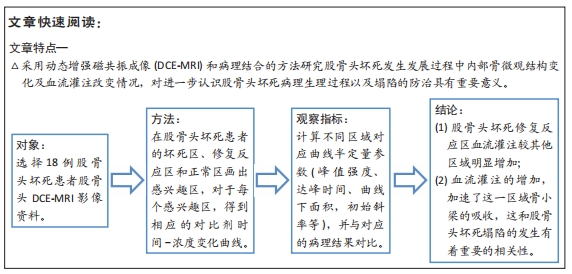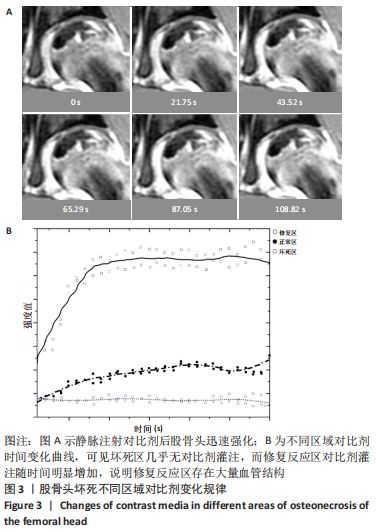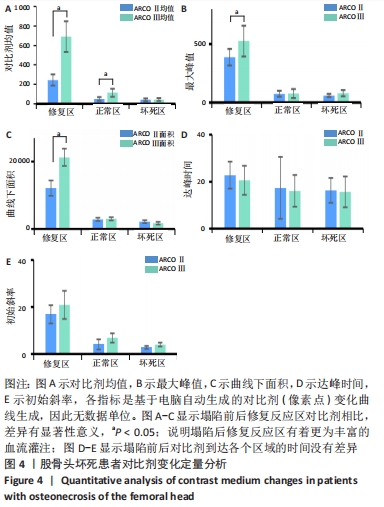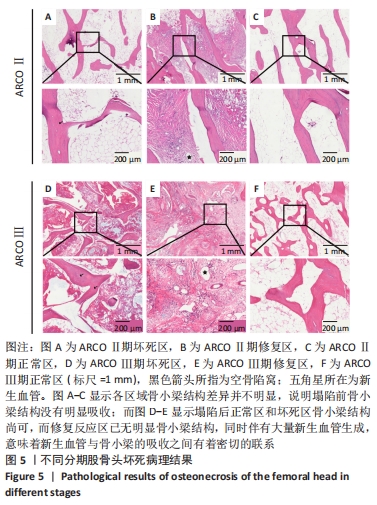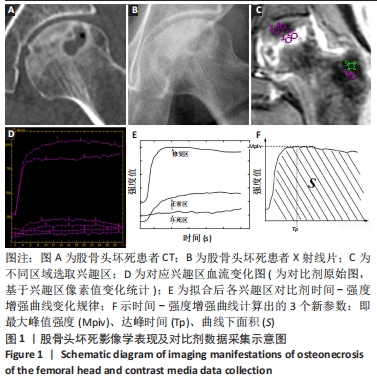[1] 赵德伟,胡永成,李子荣.中国成人股骨头坏死临床诊疗指南(2020) [J]. 中华骨科杂志,2020,40(20):1365-1376.
[2] COHEN-ROSENBLUM A, CUI Q. Osteonecrosis of the Femoral Head. Orthop Clin North Am. 2019;50(2):139-149.
[3] WANG A, REN M, WANG J. The pathogenesis of steroid-induced osteonecrosis of the femoral head: A systematic review of the literature. Gene. 2018;671:103-109.
[4] MONT MA, SALEM HS, PIUZZI NS, et al. Nontraumatic Osteonecrosis of the Femoral Head: Where Do We Stand Today: A 5-Year Update. J Bone Joint Surg Am. 2020;102(12):1084-1099.
[5] WINZENRIETH R, CLAUDE I, HOBATHO MC, et al. Is there functional vascular information in anatomical MR sequences? A preliminary in vivo study. IEEE Trans Biomed Eng. 2006;53(6):1190-1195.
[6] COVA M, KANG YS, TSUKAMOTO H, et al. Bone marrow perfusion evaluated with gadolinium-enhanced dynamic fast MR imaging in a dog model. Radiology. 1991;179(2):535-539.
[7] SIMMONS DJ, DAUM WJ, TOTTY W, et al. Correlation of MRI images with histology in avascular necrosis in the hip. A preliminary study. J Arthroplasty. 1989;4(1):7-14.
[8] SAKAI T, SUGANO N, NISHII T, et al. MR findings of necrotic lesions and the extralesional area of osteonecrosis of the femoral head. Skeletal Radiol. 2000;29(3):133-141.
[9] YAMAMOTO H, UESHIMA K, SAITO M, et al. Evaluation of femoral perfusion using dynamic contrast-enhanced MRI after simultaneous initiation of electrical stimulation and steroid treatment in an osteonecrosis model. Electromagn Biol Med. 2018;37(2):84-94.
[10] MA JX, HE WW, ZHAO J, et al. Bone Microarchitecture and Biomechanics of the Necrotic Femoral Head. Sci Rep. 2017;7(1):13345.
[11] GEITH T, NIETHAMMER T, MILZ S, et al. Transient Bone Marrow Edema Syndrome versus Osteonecrosis: Perfusion Patterns at Dynamic Contrast-enhanced MR Imaging with High Temporal Resolution Can Allow Differentiation. Radiology. 2017;283(2):478-485.
[12] BUDZIK JF, LEFEBVRE G, FORZY G, et al. Study of proximal femoral bone perfusion with 3D T1 dynamic contrast-enhanced MRI: a feasibility study. Eur Radiol. 2014;24(12):3217-3223.
[13] MONT MA, JONES LC, EINHORN TA, et al. Osteonecrosis of the femoral head. Potential treatment with growth and differentiation factors. Clin Orthop Relat Res. 1998;(355 Suppl):S314-335.
[14] TRUETA J. The normal vascular anatomy of the femoral head in adult man. 1953. Clin Orthop Relat Res. 1997;(334):6-14.
[15] RADKE S, BATTMANN A, JATZKE S, et al. Expression of the angiomatrix and angiogenic proteins CYR61, CTGF, and VEGF in osteonecrosis of the femoral head. J Orthop Res. 2006;24(5):945-952.
[16] HAYASHI S, FUJIOKA M, IKOMA K, et al. Evaluation of femoral perfusion in a rabbit model of steroid-induced osteonecrosis by dynamic contrast-enhanced MRI with a high magnetic field MRI system. J Magn Reson Imaging. 2015;41(4):935-940.
[17] YANKEELOV TE, GORE JC. Dynamic Contrast Enhanced Magnetic Resonance Imaging in Oncology: Theory, Data Acquisition, Analysis, and Examples. Curr Med Imaging Rev. 2009;3(2):91-107.
[18] LI W, SAKAI T, NISHII T, et al. Distribution of TRAP-positive cells and expression of HIF-1alpha, VEGF, and FGF-2 in the reparative reaction in patients with osteonecrosis of the femoral head. J Orthop Res. 2009; 27(5):694-700.
[19] KIM HK, SANDERS M, ATHAVALE S, et al. Local bioavailability and distribution of systemically (parenterally) administered ibandronate in the infarcted femoral head. Bone. 2006;39(1):205-212.
[20] GOU WL, LU Q, WANG X, et al. Key pathway to prevent the collapse of femoral head in osteonecrosis. Eur Rev Med Pharmacol Sci. 2015; 19(15):2766-2774.
[21] FAN M, WANG AY, WANG Y, et al. [A new animal model of osteonecrosis induced by focal alternative cooling and heating insults]. Zhongguo Yi Xue Ke Xue Yuan Xue Bao. 2011;33(4):375-381.
[22] WHITAKER M, GUO J, KEHOE T, et al. Bisphosphonates for osteoporosis--where do we go from here? N Engl J Med. 2012;366(22):2048-2051.
[23] ASTRAND J, ASPENBERG P. Systemic alendronate prevents resorption of necrotic bone during revascularization. A bone chamber study in rats. BMC Musculoskelet Disord. 2002;3:19.
[24] ALMEIDA HV, ESWARAMOORTHY R, CUNNIFFE GM, et al. Fibrin hydrogels functionalized with cartilage extracellular matrix and incorporating freshly isolated stromal cells as an injectable for cartilage regeneration. Acta Biomater. 2016;36:55-62.
[25] PERALTA C, JIMÉNEZ-CASTRO MB, GRACIA-SANCHO J. Hepatic ischemia and reperfusion injury: effects on the liver sinusoidal milieu. J Hepatol. 2013;59(5):1094-1106.
[26] YU L, YANG G, ZHANG X, et al. Megakaryocytic Leukemia 1 Bridges Epigenetic Activation of NADPH Oxidase in Macrophages to Cardiac Ischemia-Reperfusion Injury. Circulation. 2018;138(24):2820-2836.
[27] GOTTLIEB RA. Cell death pathways in acute ischemia/reperfusion injury. J Cardiovasc Pharmacol Ther. 2011;16(3-4):233-238.
[28] ANDERSON PA, JERAY KJ, LANE JM, et al. Bone Health Optimization: Beyond Own the Bone: AOA Critical Issues. J Bone Joint Surg Am. 2019; 101(15):1413-1419.
[29] GADDINI GW, GRANT KA, WOODALL A, et al. Twelve months of voluntary heavy alcohol consumption in male rhesus macaques suppresses intracortical bone remodeling. Bone. 2015;71:227-236.
[30] KAHLER-QUESADA AM, GRANT KA, WALTER NAR, et al. Voluntary Chronic Heavy Alcohol Consumption in Male Rhesus Macaques Suppresses Cancellous Bone Formation and Increases Bone Marrow Adiposity. Alcohol Clin Exp Res. 2019;43(12):2494-2503.
[31] PELED E, DAVIS M, AXELMAN E, et al. Heparanase role in the treatment of avascular necrosis of femur head. Thromb Res. 2013;131(1):94-98.
|
